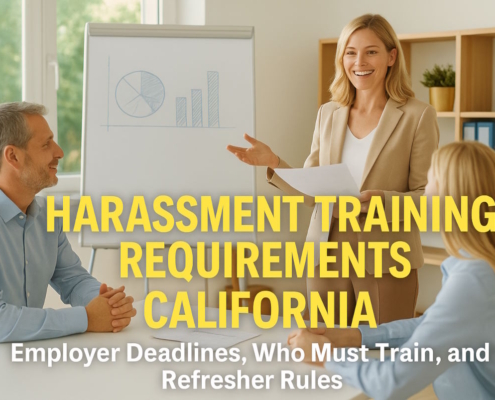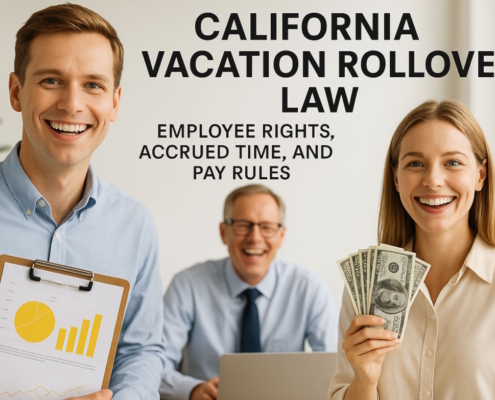What is co employment: how to minimize risk?
Co-employment is a contractual relationship where a professional employer organization (PEO) and a business share employment responsibilities such as job duties and payroll.
By Douglas Wade, Attorney
Email | Call (800) 484-4610
Get Smarter. Search FAQs.
What is co-employment?
Co-employment refers to a legal concept where two or more employers share the responsibility and liability for the same employee or group of employees. In a co-employment arrangement, the employees work for one employer but are economically dependent on or controlled by another entity, which may be a staffing agency, professional employer organization (PEO), or a client company.
Co-employment usually arises in situations where there is a contractual relationship between two employers regarding the provision of labor or services. The primary employer, often referred to as the “client company” or “worksite employer,” has day-to-day control over the employees’ work activities, while the secondary employer, such as a staffing agency or PEO, handles administrative tasks such as payroll, benefits, and human resources management.
The key aspect of co-employment is that both the primary and secondary employers have certain legal obligations and liabilities towards the shared employees. They may share responsibilities related to wages, taxes, compliance with employment laws, workplace safety, and other employment-related matters. The specific division of responsibilities and liabilities is usually outlined in the contractual agreement between the parties involved.
Co-employment can offer benefits to all parties involved. For example, the client company may gain access to a flexible workforce without assuming the full responsibilities of being an employer, while the staffing agency or PEO can leverage their expertise to handle administrative tasks. However, it is essential that both employers understand their respective obligations and comply with applicable laws to avoid legal issues and ensure the well-being of the shared employees.
What are the risks of co-employment?
Co-employment can create several risks that employers need to be aware of and manage effectively. Our employer defense litigation attorneys sees the following common risks associated with co-employment:
- Legal and Compliance Risks: Co-employment can create complexities in terms of legal responsibilities and compliance with employment laws. Both the primary and secondary employers may be jointly liable for issues such as wage and hour violations, workplace discrimination, harassment claims, and failure to provide required benefits. Failing to meet legal obligations can result in lawsuits, penalties, damage to reputation, and financial loss.
- Lack of Control and Communication: In a co-employment arrangement, the primary employer retains control over the employees’ day-to-day work activities, but the secondary employer typically handles administrative tasks. This division of responsibilities can lead to challenges in communication and coordination between the two employers. Miscommunication or lack of coordination may result in inconsistent policies, confusion among employees, and potential disruptions to productivity.
- Employee Relations and Morale: Co-employment can affect employee morale and engagement if employees perceive a lack of clarity regarding their employment status, reporting relationships, or career advancement opportunities. Employees may feel caught between two employers, leading to a sense of uncertainty, reduced loyalty, and decreased job satisfaction. It is crucial for both employers to establish clear channels of communication and provide support to address employee concerns.
- Financial Implications: Co-employment arrangements may involve additional costs, such as fees charged by the secondary employer for their services, insurance premiums, and administrative expenses. Employers need to carefully assess the financial impact of co-employment and ensure that the benefits outweigh the associated costs. Failure to manage these financial aspects effectively can strain the overall budget and profitability.
- Risks to Reputation: If co-employment is not managed properly, it can impact the reputation of both the primary and secondary employers. Negative experiences of employees, legal disputes, or instances of non-compliance with employment laws can tarnish the image of the organizations involved. Maintaining a positive reputation is crucial for attracting and retaining top talent, securing client relationships, and fostering trust among stakeholders.
To mitigate these risks, employers considering co-employment should engage in thorough due diligence, establish clear contractual agreements, and ensure compliance with applicable laws. It is essential to maintain open lines of communication, clarify roles and responsibilities, and provide support to employees to minimize potential challenges and foster a positive working environment. Consulting with legal professionals and industry experts can also help in navigating the complexities of co-employment and mitigating associated risks.
How can you address co-employment risks?
Mitigating co-employment risks requires careful planning, proactive measures, and effective communication between the parties involved. The following are some helpful strategies that can mitigate co-employment risks:
- Clear Contractual Agreements: Establishing well-defined and comprehensive contractual agreements between the primary and secondary employers is essential. The contract should outline the roles, responsibilities, and liabilities of each party, including compliance with employment laws, payment of wages, benefits administration, and dispute resolution mechanisms. Clearly defining the scope of the co-employment relationship helps manage expectations and minimizes potential misunderstandings.
- Compliance with Employment Laws: Both the primary and secondary employers must stay up to date with relevant employment laws and regulations. This includes understanding wage and hour laws, anti-discrimination regulations, occupational health and safety requirements, and other legal obligations. Compliance with these laws helps reduce the risk of legal disputes, penalties, and damage to company reputation. Legal counsel or Human Resources professionals with expertise in employment law can provide guidance and ensure compliance.
- Effective Communication and Coordination: Establishing open lines of communication and maintaining regular contact between the primary and secondary employers is crucial. Clear channels for sharing information, policies, and procedures should be established to ensure consistency and alignment. Regular meetings, joint training sessions, and performance reviews can help foster effective communication and coordination, minimizing misunderstandings and potential risks.
- Employee Education and Support: It is important to educate employees about the co-employment relationship, their rights, and the responsibilities of each employer. Transparent communication about reporting structures, employment benefits, and policies can help alleviate employee concerns and maintain morale. Offering support mechanisms, such as reporting procedures and a point of contact for addressing co-employment-related issues, can provide employees with a sense of security and mitigate potential risks.
- Ongoing Monitoring and Auditing: Regular monitoring and reviewing of the co-employment relationship can help identify any compliance gaps or issues. This may involve conducting internal audits, reviewing payroll records, ensuring proper classification of employees, and assessing overall compliance with employment laws and contractual agreements. By identifying and addressing issues promptly, employers can proactively manage risks and maintain legal and regulatory compliance.
- Partner Selection and Due Diligence: When selecting a secondary employer, such as a staffing agency or PEO, thorough due diligence is crucial. Evaluate their reputation, track record, expertise, and financial stability. Review their compliance practices, insurance coverage, and risk management procedures. Choosing a reputable and reliable partner helps reduce the likelihood of potential risks associated with co-employment.
- Regular Review of Co-Employment Arrangements: Co-employment arrangements should be periodically reviewed to ensure they remain aligned with the evolving needs and goals of all parties involved. This includes reviewing the contractual agreements, performance metrics, and overall effectiveness of the co-employment relationship. Adjustments or modifications may be necessary to address changing circumstances or mitigate emerging risks.
What is the role of an employer in a co-employment relationship?
In a co-employment relationship, the employer’s role can vary depending on whether they are the primary employer (client company) or the secondary employer (staffing agency or PEO). An employer in a co-employment relationship will typically have the following roles and responsibilities:
- Payroll: The employer, whether the primary or secondary employer, is responsible for ensuring accurate and timely payment of wages to the employees. This includes maintaining payroll records, calculating and withholding taxes, processing deductions, and issuing paychecks or direct deposits. The primary employer may provide the necessary information on hours worked or services rendered to the secondary employer for payroll processing.
- Benefits Administration: The employer, usually the secondary employer, is responsible for administering employee benefits, such as health insurance, retirement plans, and other applicable benefits. This involves enrollment, eligibility verification, contribution management, and communication with employees regarding benefit options and changes. The specific benefits offered may depend on the contractual agreement between the primary and secondary employers.
- Required Employer Insurances: Employers, regardless of their role in the co-employment relationship, are typically required to maintain certain insurance coverage. This commonly includes workers’ compensation insurance, which provides coverage for work-related injuries or illnesses. Other types of insurance, such as general liability insurance or professional liability insurance, may also be required based on the nature of the work or industry. Compliance with insurance requirements helps protect the interests of both employers and employees.
- Compliance with Federal, State, and Local Laws: Employers in a co-employment relationship must comply with various federal, state, and local employment laws and regulations. These include laws related to minimum wage, overtime pay, anti-discrimination, family and medical leave, and workplace safety, among others. Both the primary and secondary employers share the responsibility of ensuring compliance with these laws, although specific obligations may be outlined in the contractual agreement.
The primary employer retains control over the day-to-day work activities of the employees, while the secondary employer typically handles administrative tasks such as payroll and benefits. However, the specific division of responsibilities may vary based on the contractual agreement and the nature of the co-employment relationship. Clear communication and coordination between the two employers are crucial to ensure compliance with applicable laws and provide a seamless experience for the shared employees. To better navigate the complexities of compliance in co-employment relationships, one should not hesitate to consult with legal counsel.
How to make sure co-employment is not seen as joint employment?
To ensure that a co-employment relationship is not viewed as a joint employer relationship, it is important to establish and maintain certain practices and boundaries. The following are some general strategies to minimize the perception of a joint employer relationship:
- Clear Contractual Agreements: Create a comprehensive written contract that clearly defines the roles, responsibilities, and expectations of each party involved. The contract should clearly state that the primary employer retains control over day-to-day work activities, while the secondary employer handles administrative tasks. It should also outline the limits of each employer’s authority and decision-making powers.
- Avoid Direct Control: The primary employer should avoid exercising direct control or micromanagement over the employees who are shared through the co-employment arrangement. It is important to maintain a clear distinction between the primary employer’s role in overseeing work performance and the secondary employer’s role in administrative functions.
- Communication Channels: Establish effective communication channels between the primary and secondary employers to ensure proper coordination and exchange of information. However, it is important to avoid giving the impression that the secondary employer is being directed or controlled by the primary employer. Communication should primarily focus on necessary information exchange rather than directives regarding work assignments or supervision.
- Separate Human Resources Functions: Maintain separate HR departments for each employer, handling their respective functions. The primary employer should handle performance management, discipline, and day-to-day supervision, while the secondary employer can handle administrative HR functions like payroll, benefits administration, and employment documentation.
- Independent Decision-making: Encourage independent decision-making by the secondary employer in areas related to employment matters. This includes decisions on hiring, firing, promotions, compensation, and other HR-related aspects. The secondary employer should have the autonomy to make these decisions within the parameters set by the primary employer.
- Transparent Employee Relationships: Clearly communicate to employees the nature of the co-employment relationship, including the roles and responsibilities of each employer. Employees should understand the reporting structure, authority hierarchy, and who they should approach for different employment-related matters. It is important to avoid creating confusion or ambiguity regarding employment status or supervisory relationships.
- Compliance with Laws: Ensure compliance with all relevant employment laws and regulations. Both the primary and secondary employers should independently meet their legal obligations, including wage and hour laws, anti-discrimination laws, and health and safety regulations. Demonstrating compliance with these laws reinforces the separation of employer responsibilities and reduces the perception of joint employment.
Have a quick question? We answered nearly 2000 FAQs.
See all blogs: Business | Corporate | Employment
Most recent blogs:































